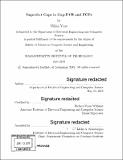| dc.contributor.advisor | Richard Ryan Williams. | en_US |
| dc.contributor.author | Vyas, Nikhil(Electrical engineer and computer scientist)Massachusetts Institute of Technology. | en_US |
| dc.contributor.other | Massachusetts Institute of Technology. Department of Electrical Engineering and Computer Science. | en_US |
| dc.date.accessioned | 2019-11-04T20:23:27Z | |
| dc.date.available | 2019-11-04T20:23:27Z | |
| dc.date.copyright | 2019 | en_US |
| dc.date.issued | 2019 | en_US |
| dc.identifier.uri | https://hdl.handle.net/1721.1/122771 | |
| dc.description | Thesis: S.M., Massachusetts Institute of Technology, Department of Electrical Engineering and Computer Science, 2019 | en_US |
| dc.description | Cataloged from PDF version of thesis. | en_US |
| dc.description | Includes bibliographical references (pages 45-47). | en_US |
| dc.description.abstract | In this thesis we study the role of perfect completeness in probabilistically checkable proof systems (PCPs) and give a new way to transform a PCP with imperfect completeness to a PCP with perfect completeness, when the initial gap is a constant. In particular, we show that PCP[subscript c,s][r, q] [mathematical symbol] PCP[subscript 1,s'][r + 0(1), q+ 0 (r)] for c - s = [omega](1) which in turn implies that one can convert imperfect completeness to perfect in linear-sized PCPs for NTIME[0(n)] with a 0(log n) additive loss in the query complexity q. We show our result by constructing a "robust circuit" using threshold gates. These results are a gap amplification procedure for PCPs (when completeness is imperfect), analogous to questions studied in parallel repetition [21] and pseudorandomness [141. We also investigate the time complexity of approximating perfectly satisfiable instances of 3SAT versus those with imperfect completeness. We show that the Gap-ETH conjecture without perfect completeness is equivalent to Gap-ETH with perfect completeness; that is, MAX 3SAT(1 - [epsilon], 1 - [delta]) for [delta] > [epsilon] has 2⁰([superscript n])-time algorithms if and only if MAX 3SAT(1, 1 - [delta]) has 2⁰([superscript n])-time algorithms. We also relate the time complexities of these two problems in a more fine-grained way, to show that T₂ (n) </= T₁ (n(log log n)⁰(¹)), where T₁(n), T₂(n) denote the randomized time-complexity of approximating MAX 3SAT with perfect and imperfect completeness, respectively. This is joint work with Mitali Bafna. | en_US |
| dc.description.statementofresponsibility | by Nikhil Vyas. | en_US |
| dc.format.extent | 47 pages ; | en_US |
| dc.language.iso | eng | en_US |
| dc.publisher | Massachusetts Institute of Technology | en_US |
| dc.rights | MIT theses are protected by copyright. They may be viewed, downloaded, or printed from this source but further reproduction or distribution in any format is prohibited without written permission. | en_US |
| dc.rights.uri | http://dspace.mit.edu/handle/1721.1/7582 | en_US |
| dc.subject | Electrical Engineering and Computer Science. | en_US |
| dc.title | Imperfect gaps in Gap-ETH and PCPs | en_US |
| dc.type | Thesis | en_US |
| dc.description.degree | S.M. | en_US |
| dc.contributor.department | Massachusetts Institute of Technology. Department of Electrical Engineering and Computer Science | en_US |
| dc.identifier.oclc | 1125006408 | en_US |
| dc.description.collection | S.M. Massachusetts Institute of Technology, Department of Electrical Engineering and Computer Science | en_US |
| dspace.imported | 2019-11-04T20:23:26Z | en_US |
| mit.thesis.degree | Master | en_US |
| mit.thesis.department | EECS | en_US |
